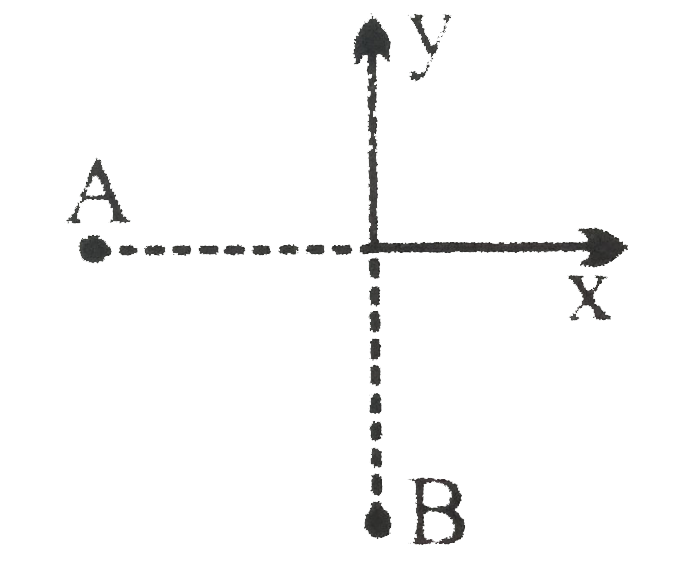A particle A moves along the line, y=30m with a constant velocity, v parallel to x-axis. At the moment particle A passes the y-axis, a particle B starts from the origin with zero initial speed and a constant acceleration, a=0.40m/sec2. The angle between a and y-axis is 60∘. If the particles A and B collide after sometimes, then the value of |v| will be Solution in Telugu
2 m/s
3 m/s
4 m/s
5 m/s
The correct Answer is:B
As shown in the figure, two particles are moving with velocity v and acceleration a.

Let the time of collision of two particles be t, then the equation of motion,
s=ut+12at2
For particle A,
30m=(0)t+acos60∘t22
⇒30=0.42×12×t2
t=√300
Hence, in time t=√300, both travelled equal distance in horizontal direction, so that the collision takes place
⇒ut=12acos30∘t2(∴30∘=90∘−60∘)
⇒u=12×0.4×√32×√300
⇒u=3m/s
Hence, the correct option is (b).
Topper's Solved these Questions
Similar Questions
The pressure on a circular plate is measured by measuring the force on the plate and the radius of the plate. If the errors in measurement of the force and the radius are 5% and 3% respectively, the percentage of error in the measurement of pressure is
View SolutionAssertion (A) The number 0.00764 has three significant figures.
Reason (R ) If the number is less than 1, the zeros on the right of the decimal point but to the left of the first non-zero digit are not significant.
View Solution
A particle mass parallel to x-axis with constant velocity v as shown in the figure. The angular velocity of the particle about the origin O
View SolutionParticles A and B are moving with constant velocities along x and y axis respectively, the graph of separation between them with time is

View SolutionAt t=0, the particle is at the origin and its velocity is 10m/s at an angle 37∘ with the x-axis. The particle moves in x−y plane with a constant acceleration of 1m/s2 along the y-axis. Find the magnitude and direction of the velocity after 2s.
View SolutionA particle A is at origin and particle B is at distance y=−d at t=0. They move with constant velocity v, A towards positive x-axis and B towards origin. The time at which distance between them is minimum and minimum distance will be
View SolutionThree particles start from origin at the same time: one with velocity v^(1) along positive x-axis, the second along the positive y-axis with a velocity v^(2) and the third along the line y = x with such a speed that all the three always stay in a straight line, then velocity of the third particles is:
View SolutionA particle moves along a straight line parallel to x-axis at a distancce d = 3 m from it, with constant speed of v = 3 m//s . Another particle stats from the origin with constant acceleration a = 4 m//s^(2) at an angle theta with y-axis along a straight line at the instant the first particle crosses y-axis. Find 'theta' such that the two particle collide.
View SolutionX-Y-तल में गतिमान एक कण पर एक बल →F=−k(yˆi+xˆj) (जहाँ k एक धन नियतांक है ) लगता है | मूल-बिंदु से प्रारम्भ करके, कण को धनात्मक X-अक्ष के अनुदिश बिंदु (a,0 ) तक ले जाया जाता है तथा फिर Y-अक्ष के समांतर बिंदु (a, a) तक | कण पर बल →F द्वारा किया गया कुल कार्य है :
View SolutionThree particles start from the origin at the same time, one with a velocity v_(1) along the x-axis, second along the negative y-axis with a velocity v_(2) and third particle moves along the line x = y. The velocity of third particle, so that three may always lie on the same line is:
View SolutionA particle moves in the x−y plane with constant acceleration of 4m.s−2 in the direction making an angle of 60∘ with the x-axis. Initially, the particle is at the origin and its velocity is 5m.s−1 along the x-axis. Find the velocity and the position of the particle at t=5s.
View SolutionA particle moves along "x" -axis with an acceleration a=12x2ms−2 .The particle has zero velocity at "x=(-2)m" .Find the velocity of the particle (in m/sec)as it passes through origin.
View SolutionIn Fig. 4-28, particle A moves along the line y = 30 m with a constant velocity vecv of magnitude 3.0m/s and parallel to the x axis. At the instant particle A passes the y axis, particle B leaves the origin with a zero initial speed and a constant acceleration veca of magnitude 0.40m//s^(2) . What angle theta between veca and the positive direction of the y axis would result in a collision?
View SolutionA particle: - is moving along the axis. Its initial velocity is 40 m / s (: - along the axis) and acceleration 10 m / s. से^2 (: -Direction of the axis). The particle starts speed from x = 10 m. The velocity of the particle will be zero in seconds
View SolutionA particle: - is moving along the axis. Its initial velocity is 40 m / s (: - along the axis) and acceleration 10 m / s. से^2 (: -Direction of the axis). The particle starts speed from x = 10 m. The velocity of the particle at the point of origin is ... m / s.
View Solution

